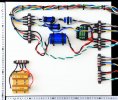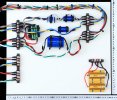- Thread Starter
- #901
Nice cabling work. But why "protecting" capacitors? There is no need for but may influence the sound.
Protecting capacitors are there, to prevent an amplifier output device failure, from blowing the unobtanium (Be)midrange and tweeters. ( by applying a power supply rail voltage at high current availability) When properly selected which @dualazmak has done they are unlikely to be audible. They are essentially electronically transparent.
The argument to prevent bass tones from the midrange and tweeter is questionable since the crossover should do this. What about the woofer? Is there no protection capacitor? Prevention from high DC value can be done with so called crowbar circuit which shortens in case of DC. I agree that a capacitor is easier to implement. And using relais like in many amplifiers might not be perfect over time due to contact degradation.
Hello SSS and gene_stl:
Thank you for your interests and comments which I understood well.
At least in my setup, of course I carefully measured and confirmed that the protection capacitors are essentially transparent and "inaudible"; please refer to my posts here #402 and #485 (as well as #258 for subjective comparison).
I use these protection capacitors for protecting my treasure Be-midrange-squawkers, Be-tweeters, and metal horn super-tweeters from possible accidental intrusion of low Fq signal and/or DC.
In the course of intensive DIY of DSP-based multichannel multi-SP-driver multi-amplifier "fully active" audio setup, we have several possibilities of such unexpected "accidents", e.g. mis-configuration/mis-typing in XO/EQ/Group-Delay/Gain settings, mis-connection of line-level and/or SP-high-level cables, unexpected pop due to "excessively buffered" signal intrusion when changed the XLR cables, etc., etc.
I actually experienced a few such cases (even I have been always much careful though) that the protection capacitors actually did their job perfectly protecting my treasure SP drivers. Consequently and fortunately, I never lost/damaged my treasure SP drivers thanks to the protection capacitors.
I also understand @SSS's concerns on "relays" within amplifiers which are relating to QC, durability and warranty of amplifiers; I mean which and what relays the manufacturer would select and use (in some cases they use oxygen-free pressurized nitrogen or SF6 filled fully shielded/covered relays), as well as maintenance service availabilities even after the warranty period for long years. This issue wound be one of the critical factors for our amplifier selection. At least in my case, I very much carefully selected my four amplifiers in this respect too. You would please refer to my summary post here. Fortunately, my amplifiers are still in excellent perfect healthy conditions. My post here would be also your interest and reference, I assume.
Accuphase, Yamaha and Sony are still providing nice maintenance/repair services for any of their present and past products with reasonable cost, and we also have several domestic third-party maintenance/repair firms for these amplifiers.
BTW, just for your convenience and further overview, you can find here (on this thread) and here (remote independent thread post) the Hyperlink Index for this project thread.
Last edited:


